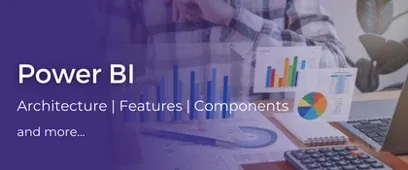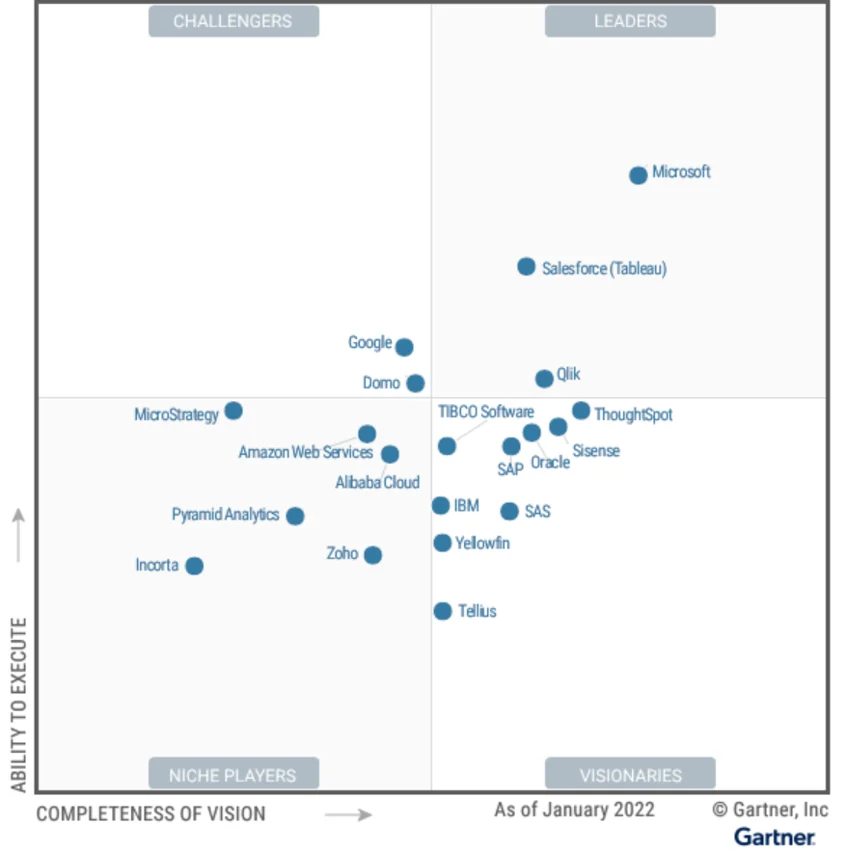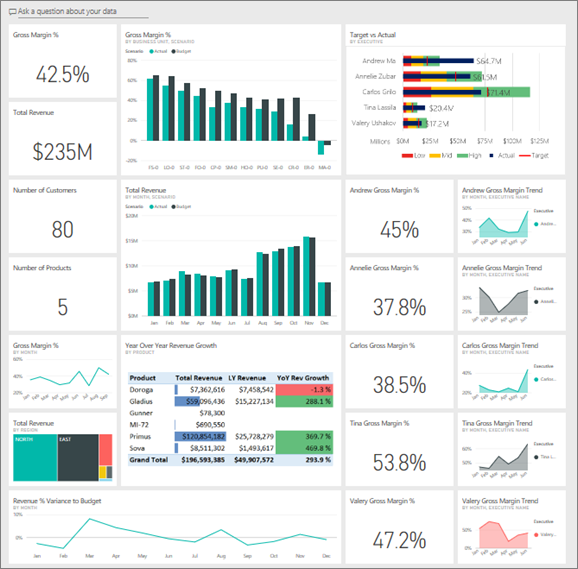What is Power BI? Features, Types of Visualization, and Components

Power BI is recognized as one of the most in-demand skills in the domain of Data Science. It is used to visualize any data using the unified, scalable platform for self-service and enterprise business intelligence (BI) that’s easy to use and helps you gain deeper data insight.
In this article, you will learn the following:
- The fundamentals of Power BI
- Types of visualizations in Power BI
- Features of Power BI
- Components of Power BI
Let us dive into a situation where you are driving a vehicle; you keep checking your speed, odometer, fuel gauge, and the music you are playing, or you attend phone calls from your car’s dashboard. A dashboard helps you in critical situations like overtaking the vehicle, reaching your destination on time, and so on. Similarly, an organization's dashboard helps companies make decisions for their organization.
Microsoft Power BI is a very powerful tool that helps Data Science professionals to process, analyze, and visualize massive amounts of data. With an easy drag-and-drop feature, it helps share insights as dashboards and reports.
What is Power BI used for?
Microsoft Power BI is a SAAS-based product that can be used for Business Intelligence. It converts data from different sources to build interactive dashboards and Business Intelligence reports. Power BI is also one of the best options available for dashboarding in 2022. It's inexpensive and simple, speeds up data preparation, modelling, and visualization.
You may also want to read Top 8 Trending Technologies in IT You Need to Know.
Why, How, and by Whom was Power BI Developed?
Gartner conducts a yearly survey on all the BI products available in the market and rates them using Magic Quadrant. Power BI from Microsoft has been a market leader since 2019.
As per the recent survey by Gartner in March 2022, Power BI is one of the market leaders that has been outperforming its other BI counterparts.

Magic Quadrant for Analytics and Business Intelligence Platforms
Source: Gartner Survey 2022
Power BI has numerous features, like exporting a dashboard to PowerPoint or Excel, extracting insights from large datasets, creating custom visualizations with R and Python, etc. Additionally, state-of-the-art data privacy technology is much cheaper than other counterparts. That is one reason why Power BI is a favorite tool for companies.
Business knowledge is the key for a Power BI Developer. For example, if you are building a financial dashboard, you will need to be aware of what are the cost overheads difference between Assets and liabilities.
Similarly, if you are planning for a product dashboard containing a software's life cycle, you need to know the software development process, versions, and agile methodology.
Using Power BI, one can do the following:
- Integrate: Power BI can integrate with various applications like Sharepoint, OneDrive, PowerAutomate, and different data sources.
- Collaborate: Power BI can collaborate to build a report in a workspace or collaborate in Microsoft Teams. You can work with multiple power BI developers and develop dashboards and information in a proper synchronized way.
- Share: After completing the dashboard, we can share the dashboard with the people inside or outside the organization. Use email, Teams, Weblink, or embedded into a website or access the dashboards using the Power BI mobile app.
You may also want to read Nine Must-Have Data Analysis Tool to Create Dashing Business Reports.
{% module_block module "widget_bd395f83-20ac-4fb6-bb36-25299d89c2a7" %}{% module_attribute "child_css" is_json="true" %}{% raw %}{}{% endraw %}{% end_module_attribute %}{% module_attribute "css" is_json="true" %}{% raw %}{}{% endraw %}{% end_module_attribute %}{% module_attribute "definition_id" is_json="true" %}{% raw %}null{% endraw %}{% end_module_attribute %}{% module_attribute "field_types" is_json="true" %}{% raw %}{"image_desktop":"image","image_link":"link","image_mobile":"image"}{% endraw %}{% end_module_attribute %}{% module_attribute "image_desktop" is_json="true" %}{% raw %}{"alt":"Blog-Listing-Ad-_4_-3","height":300,"loading":"lazy","max_height":300,"max_width":1200,"size_type":"auto","src":"https://odinschool-20029733.hs-sites.com/hubfs/Blog-Listing-Ad-_4_-3.webp","width":1200}{% endraw %}{% end_module_attribute %}{% module_attribute "image_link" is_json="true" %}{% raw %}{"no_follow":false,"open_in_new_tab":true,"rel":"noopener","sponsored":false,"url":{"content_id":null,"href":"https://www.odinschool.com/datascience-bootcamp","type":"EXTERNAL"},"user_generated_content":false}{% endraw %}{% end_module_attribute %}{% module_attribute "image_mobile" is_json="true" %}{% raw %}{"alt":"Mobile-version-of-blog-ads-_5_-2","height":300,"loading":"lazy","max_height":300,"max_width":500,"size_type":"auto","src":"https://odinschool-20029733.hs-sites.com/hubfs/Mobile-version-of-blog-ads-_5_-2.webp","width":500}{% endraw %}{% end_module_attribute %}{% module_attribute "label" is_json="true" %}{% raw %}null{% endraw %}{% end_module_attribute %}{% module_attribute "module_id" is_json="true" %}{% raw %}132581904694{% endraw %}{% end_module_attribute %}{% module_attribute "path" is_json="true" %}{% raw %}"/OdinSchool_V3/modules/Blog/Blog Responsive Image"{% endraw %}{% end_module_attribute %}{% module_attribute "schema_version" is_json="true" %}{% raw %}2{% endraw %}{% end_module_attribute %}{% module_attribute "smart_objects" is_json="true" %}{% raw %}null{% endraw %}{% end_module_attribute %}{% module_attribute "smart_type" is_json="true" %}{% raw %}"NOT_SMART"{% endraw %}{% end_module_attribute %}{% module_attribute "tag" is_json="true" %}{% raw %}"module"{% endraw %}{% end_module_attribute %}{% module_attribute "type" is_json="true" %}{% raw %}"module"{% endraw %}{% end_module_attribute %}{% module_attribute "wrap_field_tag" is_json="true" %}{% raw %}"div"{% endraw %}{% end_module_attribute %}{% end_module_block %}
Types of Visualizations in Power BI
 Source: Microsoft
Source: Microsoft
There are multiple ways in which data can be visualized. Appropriate visualizations can help us to communicate the information in a more presentable way. This can be categorized into four different types:
- Bars and column: It might be a stacked bar/column. Power BI has capabilities to add legends that can help better understand the proportion.
- Line and ribbon: Any data with date and time can be used for a line chart which means we can understand the ups and downs and previous and current patterns.
- Pie and donut: A donut or a pie chart helps us create variables' proportions. For example, how many sales have been derived from each category?
- KPI cards and gauge: KPI (a key performance indicator) is a type of visualization that helps us evaluate where we stand as per the expected goal. KPI and gauge charts help us understand the target and how we have achieved the quantifiable.
- Maps and others: Some data might be related to locations, latitude and longitude information, city names, state names, etc. When we want to visualize, we have maps that can help create visualizations for geospatial data.
Features of Power BI
 Source: Microsoft
Source: Microsoft
Features are the essential drivers which make any software or tool desired for usage. Power BI has these features that make it stand out from all the other BI competitors.
The following are the features of Power BI:
- Different Types of Visualization: You have a wide range of visualizations that we can use for our data. But, we also have a marketplace where we can import visuals for the visualizations.
- Data Connectivity: Power BI has over 100 different data source connectivity. You can pick a flat file, pull data from API, or get data from an SQL server. It is easy as well as quick.
- Filtration: We can apply parameters for filtering or filters in the power query, or else we can filter data page level, all page and visual.
- DAX(Data Analysis Expressions): DAX is a language that Power BI can understand, where we can write DAX code to create a custom measure, column, and table. There are various types of DAX functions, such as Logical DAX functions, which are the collection of logical conditioning functions like ‘if’ function, ‘or’ function, ‘and’ function, and so on. Similar to the logical DAX function, we have over 200 DAX functions, categorized text functions, aggregation functions, filter functions, financial functions, and etc.
- Refresh: Power BI has gateways and scheduled refresh, which can help us refresh the dashboard with the updated data at a specified date and time.
Power BI Architecture
To understand the various components of Power BI architecture, we must understand that all these components interact to provide a pleasant experience.
The following is the architecture of Power BI:
As per the above visual, we can see that once the dashboard is done in the Power BI desktop, it gets published to the Power BI service, wherein, using Power BI gateways, a refresh is initiated. The reports can then be viewed on your device.
Components of Power BI
Power BI comes with various applications meant for a specific purpose. All the components are mentioned below:
- Power BI Desktop: 70 - 80% of the Power BI development process happens inside Power BI. Wherein we can import the data, transform it using Power Query, write customized DAX, Create Data Models, Create RLS (Row Level Security), and visualize the data in Power BI Desktop.
- Power Query: Power Query is also available with Excel and Power BI, which is mainly used for data cleaning and ETL process. We can create calculated and conditional columns and understand data using column quality, quality profile, and distribution. All these Transformations can be performed using a unique language called M language.
- Power Maps: Maps are an integral part of Power BI and help us to visualize Geospatial data. The power maps are connected to Microsoft Bing for understanding and visualizing the locations. They are customizable as well.
- Power Pivot: Power Pivot in Power BI I almond for creating a data model creating DAX and perform.
- Power Q & A: Power BI has AI-based visualizations. One of the visualizations is Q & A visualizations, which use natural language understanding to understand what a user is asking. For example, You can ask, “What are my total sales?” Power BI can know what you have requested and provides the related visuals for your question.
- Power BI Service: After creating the dashboard, it is a standard practice to publish it in the Power BI service and apply scheduled refresh. So that the dashboard gets refreshed on time without any human interference.
- Power BI mobile: As we have discussed earlier, we can use a dashboard using the Power BI mobile application. Power BI can be accessed using mobile as well. The user cannot build or create a dashboard inside a mobile but can consume the built-in dashboard in the Power BI service.
The Future of Power BI
As the amount of data generated is increasing daily, understanding the edge of what customers want and their buying patterns are really valuable. Power BI is a tailored solution to perform this activity.
Data Science is an ever-evolving domain, but Power BI is going to be a key tool for making decisions. Every single organization requires Business Intelligence to run their organization. Some organizations may not require Data scientists. But, Business Intelligence is important. That is, Power BI is always going to be an in-demand skill.
Jobs in Power BI
Three important things will determine your career prospects in Power BI: technical knowledge of power BI, business acronyms, and skills in using the desired database.
There are abundant job openings that require Power BI skills. But, if you learn only Power BI, you won't be able to build a lucrative career. You need to have a good knowledge of SQL(MSBI), Excel, SharePoint, Dynamics 365, or API Integration. In a nutshell, Power BI alone cannot help you establish your career in Data Science.
If you want to learn Power BI and other in-demand skills in Data Science, join OdinSchool’s Data Science Course!